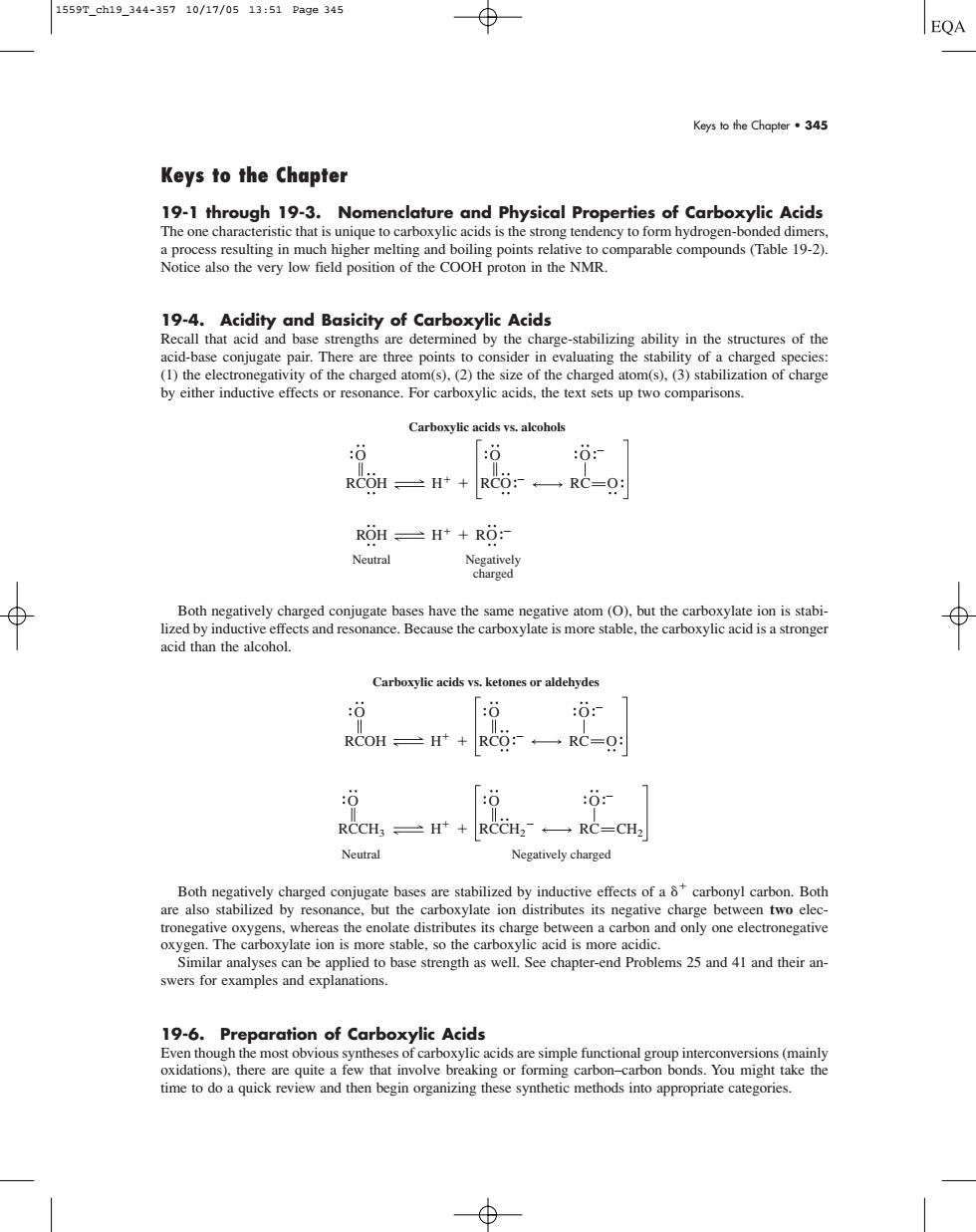正在加载图片...

1559T_ch19_344-35710/17/0513:51Pa9e345 ⊕ EQA Keys to the Chapter·345 Keys to the Chapter 19-1 through 19-3.Nomenclature and Physical Properties of Carboxylic Acids The one characteristic that is unique to carboxylic acids is the strong tendency to form hydrogen-bon nP米本 a process res e-stabilizing ability in the structures of the (D)th :0 RCOH =H++RCO: ←一RC=O: ROn一H++RO: Both negatively charged coniugate bases have the same negative atom (O).but the carboxylate ion is stabi lized by inductive effects and resonance.Because the carboxylate is more stable.the carboxylic acid is a stronger acid than the alcoho Carboxylic acids vs.ketones or aldehydes RCOH=r+RC6:一RC=: 0 :6 RCCH=H*+RCCH2←一RC=CH Neutral Negatively charged Both negatively charged conjugate bases are stabilized by inductive effects of acarbonyl carbon.Both e es and explananons 19-6.Preparation of Carboxylic Acids sions (mainl time to do a quick review and then begin organizing these synthetic methods into appropriate categories. Keys to the Chapter • 345 Keys to the Chapter 19-1 through 19-3. Nomenclature and Physical Properties of Carboxylic Acids The one characteristic that is unique to carboxylic acids is the strong tendency to form hydrogen-bonded dimers, a process resulting in much higher melting and boiling points relative to comparable compounds (Table 19-2). Notice also the very low field position of the COOH proton in the NMR. 19-4. Acidity and Basicity of Carboxylic Acids Recall that acid and base strengths are determined by the charge-stabilizing ability in the structures of the acid-base conjugate pair. There are three points to consider in evaluating the stability of a charged species: (1) the electronegativity of the charged atom(s), (2) the size of the charged atom(s), (3) stabilization of charge by either inductive effects or resonance. For carboxylic acids, the text sets up two comparisons. Both negatively charged conjugate bases have the same negative atom (O), but the carboxylate ion is stabilized by inductive effects and resonance. Because the carboxylate is more stable, the carboxylic acid is a stronger acid than the alcohol. Both negatively charged conjugate bases are stabilized by inductive effects of a carbonyl carbon. Both are also stabilized by resonance, but the carboxylate ion distributes its negative charge between two electronegative oxygens, whereas the enolate distributes its charge between a carbon and only one electronegative oxygen. The carboxylate ion is more stable, so the carboxylic acid is more acidic. Similar analyses can be applied to base strength as well. See chapter-end Problems 25 and 41 and their answers for examples and explanations. 19-6. Preparation of Carboxylic Acids Even though the most obvious syntheses of carboxylic acids are simple functional group interconversions (mainly oxidations), there are quite a few that involve breaking or forming carbon–carbon bonds. You might take the time to do a quick review and then begin organizing these synthetic methods into appropriate categories. O RCOH H Neutral Negatively charged O RCO O RC O Carboxylic acids vs. ketones or aldehydes O RCCH3 RCCH2 H CH2 O O RC O RCOH H ROH Neutral Negatively charged H O RCO O RO RC O Carboxylic acids vs. alcohols 1559T_ch19_344-357 10/17/05 13:51 Page 345����������